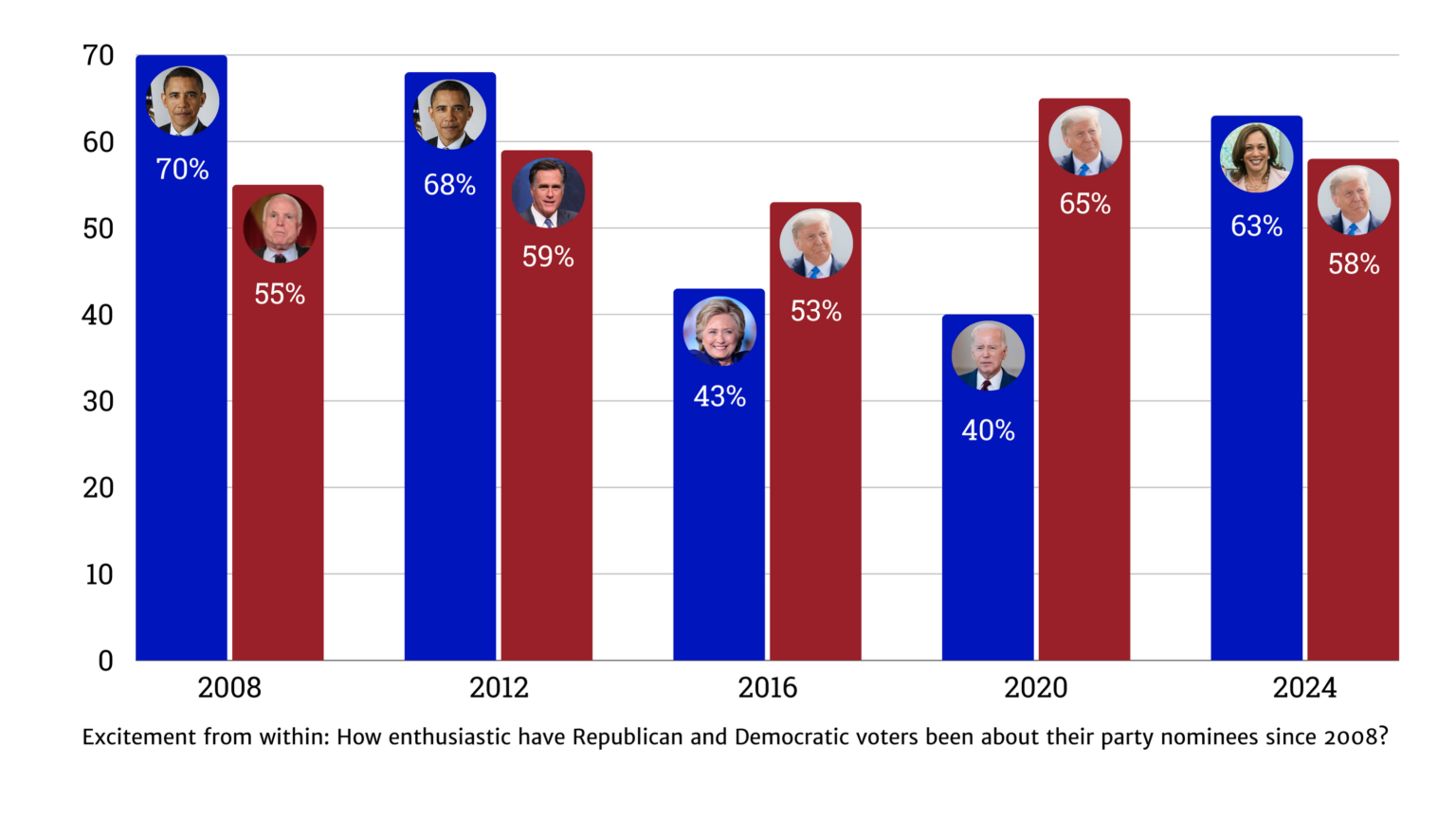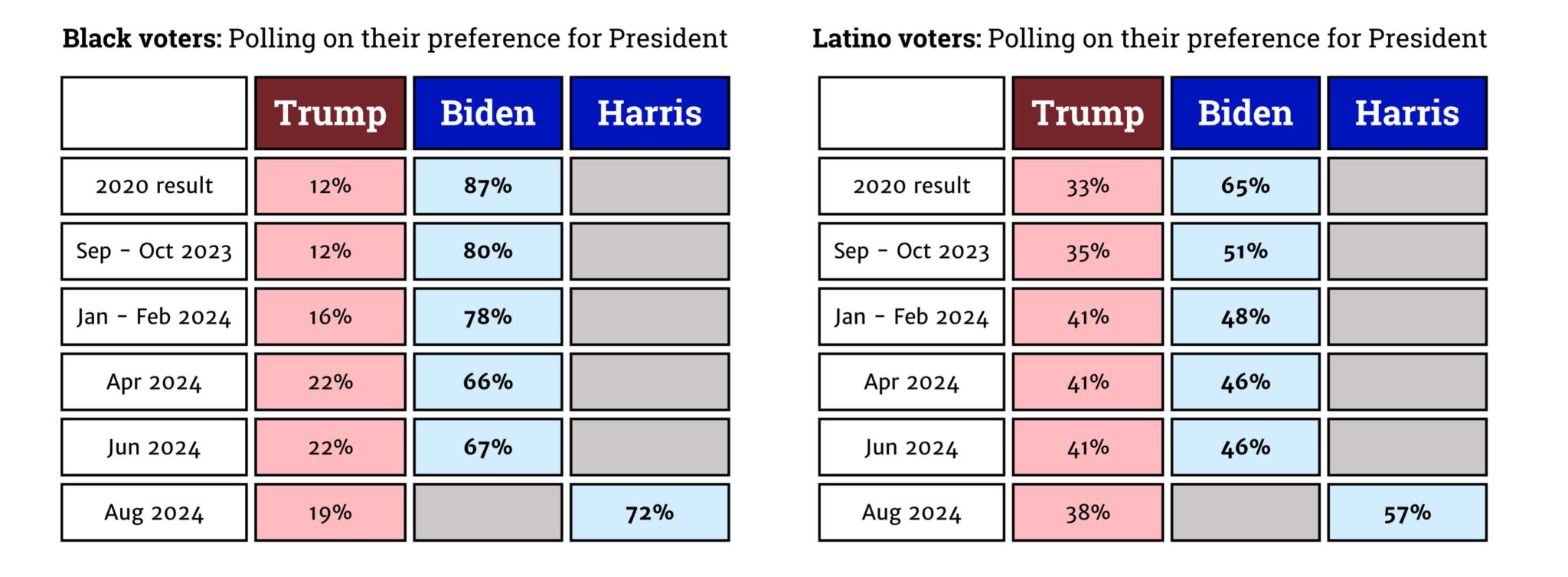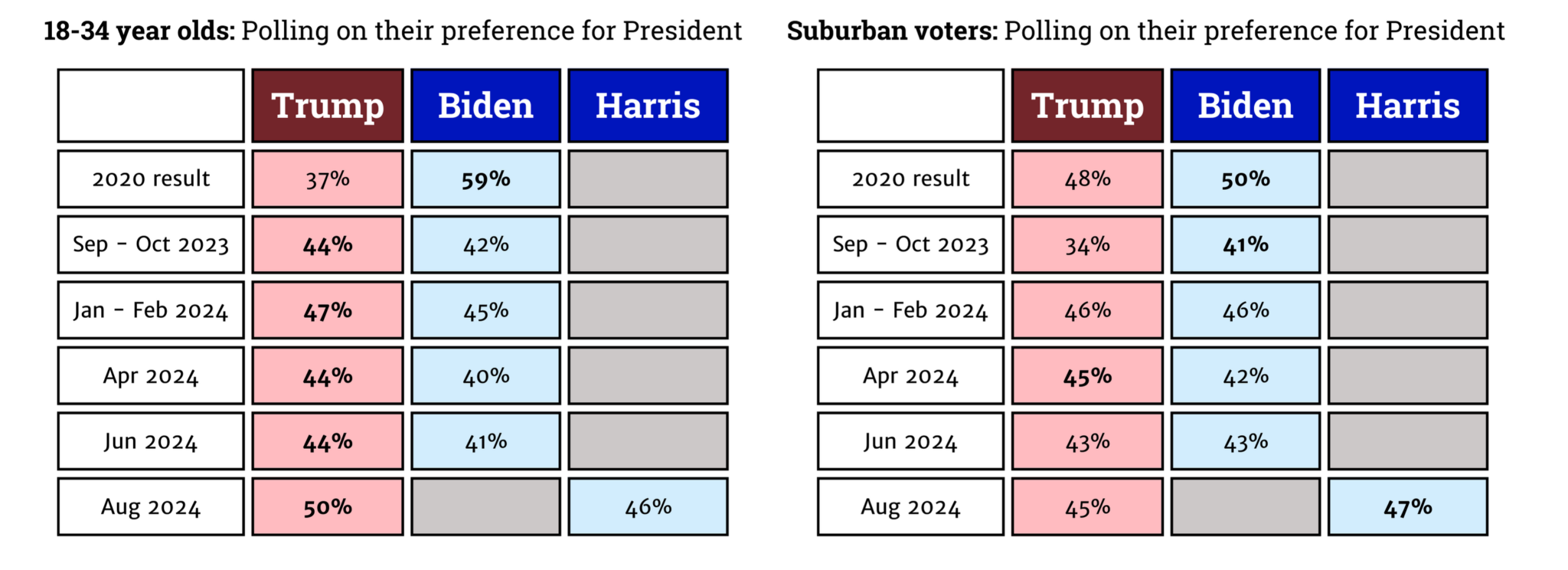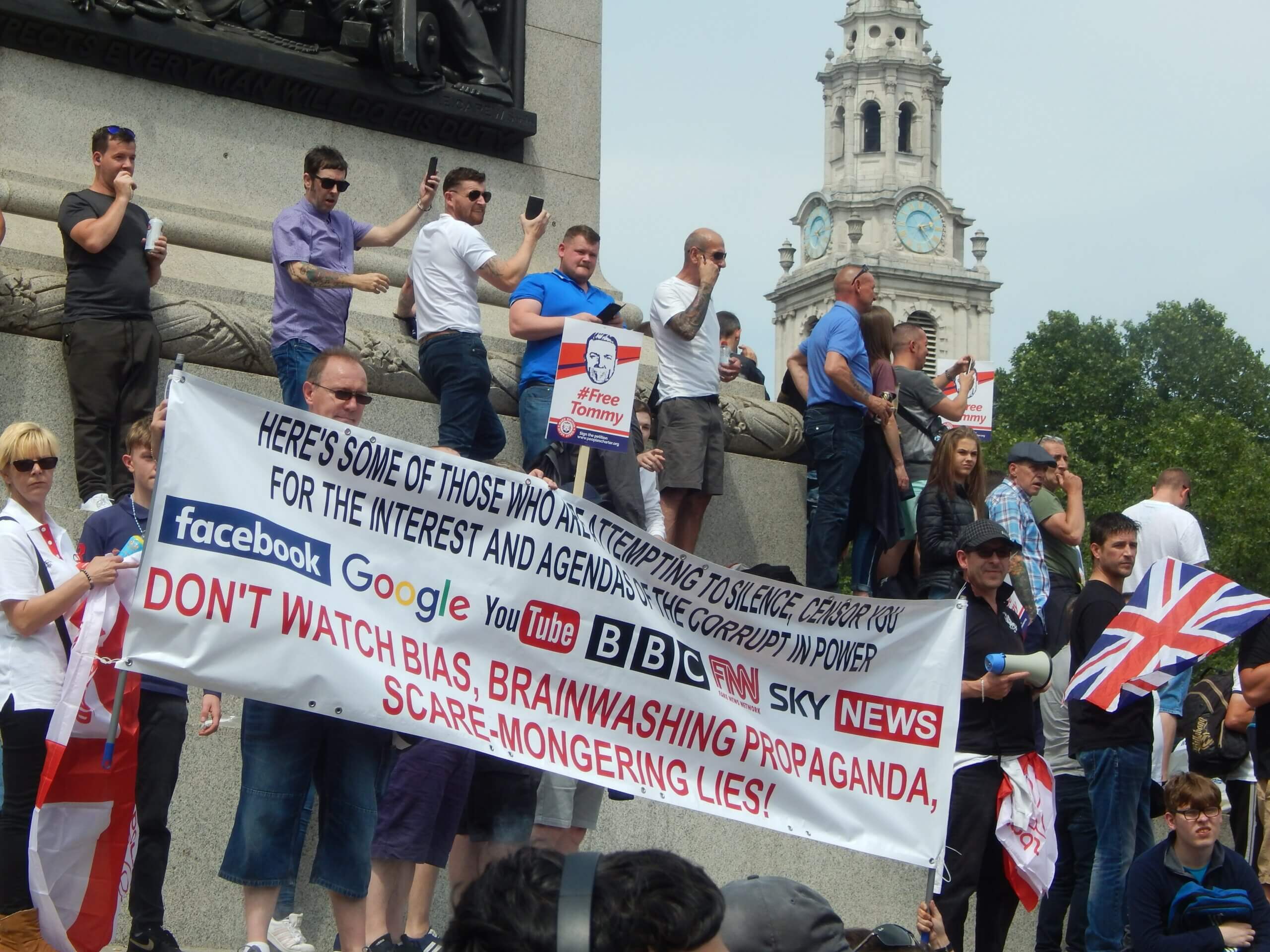Vice President Kamala Harris has had a good few weeks for numerous reasons. A combination of positive headlines and popular decisions have seen her transform the presidential race from being one that Democrats were watching with a sense of doom, to one where there is a sense of renewed hope, enthusiasm, and excitement. So, how exactly has she performed what many doubted her capable of doing?
Shattering another glass ceiling
This week she officially became the Democratic Party’s presidential candidate. Unlike in previous contests, notably 2016, she faced little resistance from prominent progressives within the party. Senator Bernie Sanders called on a packed rally in Maine to “make sure that [Harris] is elected.” Eight of the nine members of ‘The Squad’ an informal group of the Democratic Party’s most left-wing representatives in Congress urged unity to “ensure her victory in November.”
At the same time, she has also bridged the divide and attracted the support from more conservative corners of the party and country – notably from Senator Joe Manchin (68.6% of his state voted for Donald Trump in 2020), Representative Jared Golden (a Maine Democrat who represents one of 13 districts that voted for Trump in 2020), and two members of Donald Trump’s own family. The swift consolidation of party support is reminiscent of the rapid unification of much of the party around Joe Biden’s campaign in 2020 – momentum that saw him sweep the Super Tuesday nominating contests and eventually beat out Bernie Sanders to become the party’s nominee that year and defeat Trump in November.
The Democrats held a virtual ‘roll call’ of all the states earlier this week. This is a formality before the official National Convention where she will officially accept the nomination. In the roll call, 4,567 delegates committed to voting for her at the convention out of 4,593. To have over 99% of delegates supporting your candidacy demonstrates a broad unity and confidence behind Harris’ campaign – for context, 75% of delegates supported Biden in 2020, and 59% supported Clinton in 2016.
The more people see Harris, the more they like her
The increase in awareness, in name recognition, and the positive news cycle she has enjoyed has also seen Harris’ favourability ratings increase dramatically. Before Biden announced he would not be running for re-election, the Vice President was viewed in a negative light by 54% of voters. She had been viewed in such a light by a majority of voters since December 2021 and many Democrats expressed concern that this would severely damage her electoral prospects. However, following Biden’s decision, her negative ratings fell from 54% to 48%, whilst her positive ratings steeply rose from 36% to 43%. Compared to Biden, she is viewed more favourably amongst registered Democrats. 87% of registered Democrats view her positively (84% for Biden) whilst just 9% view her negatively (13% for Biden).
This increase in popularity is also reflected in her rallies that have a far more electric atmosphere than Biden’s (albeit whilst the COVID-19 pandemic limited mass public gatherings), and certainly Clinton’s in 2016. An Ipsos poll for ABC News found that 88% of Democrats were ‘enthusiastic’ about Harris’ campaign, whilst just 12% were not. Amongst the all-important ‘independent’ voters (whose votes carry significant influence in the battleground swing states), 49% are enthusiastic, 52% are not. Amongst Harris’ 88% figure, 63% are ‘very enthusiastic’. Compared to a YouGov poll from July 2020, just 40% of Democrats said the same of Biden. In an October 2016 ABC News poll, that figure was marginally higher for Hillary Clinton, whose campaign only 43% of Democrats were ‘very enthusiastic’ about.
The Harris campaign stands in good stead – the last time Democrats were this enthusiastic about their presidential nominee was for Barack Obama in 2012 when 68% were ‘strongly enthusiastic’ about his re-election campaign (just 5% ahead of a nascent Harris run).

A 'something for everyone' running mate
Another reason she has had a good few weeks is that she selected a non-contentious running mate, who if elected, would serve as her Vice President. Governor Tim Walz of Minnesota was regarded by many within the party as the ‘safe choice’.
The 60-year-old, white, male former teacher, Army National Guardsman and congressman isn’t a history-making pick, nor does he hail from a state that Harris particularly needs to win (the Democrats have won the state at a presidential level at every election since 1960, except one). However, he has a strong resume for the position. He was born in rural west Nebraska, before moving to Minnesota and getting a job as a geography teacher at a high school he also served as a football coach to. He served in the military, before running for election 2006 and defeating an incumbent Republican representative in Minnesota’s 1st Congressional District and from this point enjoying a 12 year career in the House cultivating a centre-left voting record.
He earned a reputation both as a liberal, but also a reliable vote in favour of gun rights achieving a positive rating from the highly influential National Rifle Association (NRA), who donated thousands of pounds to his re-election campaigns. However, following the deadly 2017 Las Vegas shooting, Walz, a recreational gun user himself, donated all his campaign contributions from the NRA, $18,000, to the Intrepid Fallen Heroes fund, a charity that helps families of service members who were injured or killed. Following the Parkland, Florida shooting in 2018 he came out in support for an assault weapons ban. Some gun control advocates have said he is “living proof that responsible gun ownership and support for common-sense gun safety laws can go hand-in-hand.” Since his election as Governor of Minnesota in 2018, Walz has embraced his inner progressive. Especially since Democrats gained full control of Minnesota state government in 2022, he has presided over a flurry of liberal lawmaking. For example, the state has legalised recreational marijuana, protected abortion rights, committed to transition to 100% renewable electricity by 2040 and passed a sweeping law to expand voting access.
He also tacked further left on gun rights, signing bills to expand background checks and make it easier to take guns away from people who are deemed a threat. In short, Harris selected a running mate who seemed to offer something for everyone within the Democratic coalition, with little that might alienate some voter groups. This was not necessarily the case for the other top contenders for the role – Governor Josh Shapiro of Pennsylvania, and Senator Mark Kelly of Arizona. Shapiro has faced sharp criticism for his stance on the war on Gaza, and Kelly has been viewed sceptically by union groups for not supporting pro-worker policies.
It is unlikely that her vice presidential pick will dramatically alter the race nationally – rarely does this ever happen in modern US elections, however it may shore up blue-collar support across the all-important rust belt, and soften perceptions that Harris is simply a smooth, liberal from liberal San Francisco. Crucially, though, it could deliver Minnesota’s 10 electoral votes to Harris and the Democrats once more. When running mates are announced, they tend to get a ‘home state’ lift.
For example, in 2008 when John McCain selected Alaska Governor Sarah Palin to be his running mate, he increased his campaign’s support in the state by over 10%. Likewise, in 2012 when Mitt Romney selected Wisconsin Congressman Paul Ryan to be his running mate, the campaign rose in support by 5% and briefly overtook Obama in polling in the state. Even in 2016, when Hillary Clinton selected Virginia Senator Tim Kaine as her running mate (to the chagrin of progressives across the country), her support in the state rose by approximately 7% turning a toss-up state, into one the Democrats had the upper hand in.

How these have affected the polls
Before the 21st of July and Biden’s exit from the presidential race, there was a sense of doom within the Democratic Party. The President trailed Donald Trump by more than 3% nationally, Biden was languishing in the low 40s, whilst he saw must-win states such as Michigan, Wisconsin, and Pennsylvania fall from reach. A disastrous debate performance, coupled with even more polls suggesting he could lose Virginia, Minnesota, New Hampshire, and run it close in New Jersey and New York – all states the Democrats gave held with comfortable margins since 2008, saw the voices calling for him to step aside grow from an occasional murmur to a crescendo roar from some of the party’s leading figures.
When Biden endorsed Harris, many in political circles were sceptical she would fare much better owing to her disapproval ratings and her own political baggage. However, the national polls and state polls have proven these fears to be ill-founded. Generally, the Vice President is performing more than 3% better than Biden nationally in polls conducted after his withdrawal than before it. What was a likely Trump win in November is now a toss up, whilst polls (adjusted to factor in that likely voters to take part in them tend to skew Democratic) indicate that the national political environment is +1.8% in favour of Harris.
Delving into the cross-tabs on these headline figures, Harris is gradually building back a coalition that was eroding under Biden. She is beginning to salvage support from black voters that hit a historic low under Biden, whilst her jump in support amongst Latinos to open up a 5% gap from Trump to a nearly 20% gap makes many hopeful she could be competitive in Arizona and Nevada.

Her support amongst vital suburbs voters is climbing towards 2020 levels, following a spell during which they had strayed from Biden. However, disappointingly for Harris, work remains to convince younger voters that they should vote for the party. In 2020, the Democrats won this age bracket by over 20%, but since then Trump has modestly led in this category.
Take a look at these tables to see how support for Biden and Trump, and then Harris has shifted since 2020, according to Survey USA.

However, these are nothing unless translated onto key swing states. As you can see by the diagrams below, Biden trailed Trump in all of the swing states he would need to win re-election. In some states, notably Nevada and Michigan (which tend to be the ‘most’ Democratic out of all of them), Trump was scoring double-digit leads over the President largely spurred on by the free-fall in support he was enduring from Latino voters, black voters, and young progressives across these states.
The graphs of each of the key swing states below indicate how Biden’s support collapsed following the debate between him and Trump (the dashed line). As you can see, once Harris became the nominee for her party (in the pink section of each graph), there was a notable uptick in Democratic support.

In some polls in more conservative states such as North Carolina and Georgia, she has put them back into play for the party and given Democrats hope they could win one or both of them in November. She now leads (albeit narrowly) in Michigan, Pennsylvania, Wisconsin, and Nevada – and is edging closer in Arizona and Georgia. She has reinforced key pillars of the ‘blue wall’ in Virginia, Minnesota, New Hampshire, Colorado, New York, and Oregon, all through unifying her party behind her and re-attracting formerly alienated voter groups Biden was lagging amongst.
Whilst the races in each of these states is still far too close (and early) to call, it does demonstrate that there is now a proper contest for their electoral votes rather than what many Democrats were seeing with Biden as their nominee – a drubbing by Trump.
The first three factors outlined in this article can all be justified by watching how the race has shifted in the past three weeks. With the Democratic National Convention offering to shine the brightest spotlight on Harris and Walz, expect the race to change further. Convention ‘bounces’ as they are referred to are not a myth. The 2008 Democratic Convention saw Obama’s support increase by 4% nationally, whilst the Republican one saw John McCain’s support rise by 6%. In 2016, Hillary Clinton saw her support rise by 2% following the convention, whilst Trump saw his rise by 3%. Admittedly, as the name suggests, ‘bounce’ is temporary and the honeymoon of a party crowning its new nominee then evaporates and the news cycle retakes control of the election narrative. As I said at the beginning, the past three weeks have been good for Kamala Harris – and expect them to get better, reaching a crescendo at the Democratic National Convention in mid-August, after which the final stretch of the campaign will begin. Once we pass this point, anything is possible.








